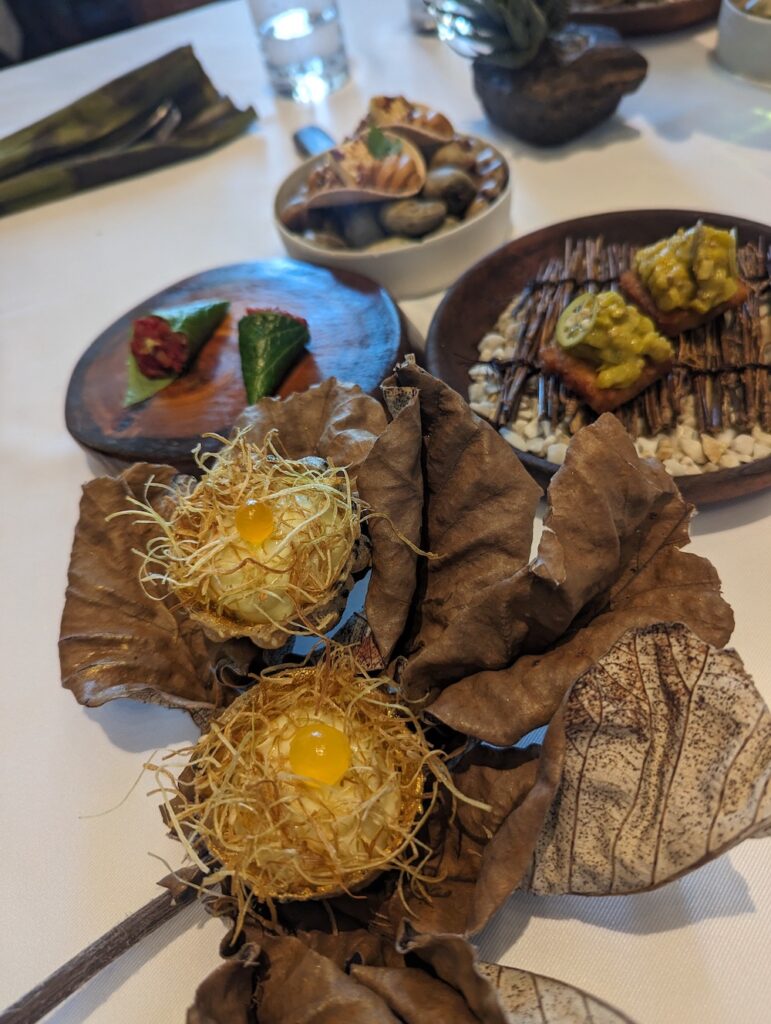D.O.M. Restaurant Review (São Paulo)

Come with me to experience the gastronomic journey of D.O.M. Restaurant in São Paulo Brazil.
If you are a foodie and avid watcher of the Netflix documentary series Chef’s Table, chances are you’re familiar with the renowned Brazilian Chef, Alex Atala.
If not, I highly recommend checking out Episode 2 of Season 2.
Brazil is such a large country in size, and has some of the richest biodiversity in the world. From the Amazon Rainforest to its 7,500 km Atlantic coastline, the diversity of ingredients that flourish on Brazilian soil is impressive. However, one might notice that the traditional Brazilian cuisine that reaches international tables doesn’t quite capture this diversity. Having grown up frequently visiting family in Brazil, I can attest that even the day-to-day Brazilian cuisine consumed by most people is centred around only a small fraction of the ingredients found throughout the country.
Alex Atala has garnered media acclaim for spearheading a movement among Brazilian chefs to incorporate authentic indigenous ingredients into mainstream Brazilian cuisine. Whether he is the true mastermind behind this renaissance of Brazilian gastronomy or simply the one who achieved international fame, over the past decade, there has indeed been a collective pride in native ingredients and techniques emerging in restaurant kitchens.
Despite these indigenous ingredients and techniques having existed for centuries, Brazilian gastronomy is evolving right before our eyes.
The Menu


We chose the 16-course menu without the wine degustation. Being six months pregnant at the time of our visit, a wine-tasting menu did not make much sense for me.
The menu kicked off with the notorious Amazonic Ant, as highlighted in the documentary.
I had been looking forward to trying this ant for years, but I must admit it went somewhat unnoticed. I had anticipated a more pronounced flavor from the actual ant, which I found to be overpowered by the piece of pineapple it rested upon. Let’s just say I wish I could give it another try to truly focus on unravelling the flavor of the insect.



Following the Amazonic Ant, we proceeded with a series of amuse-bushes and appetizers. I will not be able to explain each dish in detail since most ingredients are truly unique to Brazil and cannot be translated.
A curious twist was the unconventional serving method for all liquids, including hot soup and coffee, which arrived in wine glasses. The pumpkin soup also featured some texturized bubbles, similar to the ones found in bubble tea, at the bottom of the glass.
Unlike any other meal I’ve experienced, this one truly brought to life the saying “eating with your sight.” When a dish is presented as a narrative, piquing your curiosity, and also appearing incredibly appetizing, your senses begin to savour the meal even before the first bite. That was my experience with every dish served. I found the appetizers extremely creative and captivating, transporting you to the natural environment that the ingredients originated from.
Caviar Menu
An option to upgrade to the “Caviar Menu” is available for an additional cost of approximately USD 40. Only one member of our party opted for this upgrade, anticipating multiple dishes incorporating caviar in some shape or form. Turns out it is only one additional dish, featuring a caviar-filled cone. A bite of this luxurious ingredient is nothing short of pure decadence. However, it is really up to each guest to assess whether it is worth the menu upgrade.

Queijo Tulha, Siri Azul e Panc's


The star of the dish was the “Queijo Tulha” which is an artisinal aged cheese made with cows milk. Along with it came a crape-like roll filled with blue crab. This tiny roll was warm and fluffy and filled with so much flavour. Truly delicious!
Hollandaise de Tucupi

Tucupi is the liquid extracted from the Cassava. It is a humble ingredient with a very unique almost sour flavor. This was one of my favorite dishes. The creaminess of a classic hollandaise sauce was then balanced with the tang and exotic twist of tucupi.
The Mains


Moqueca is one of the most traditional Brazilian dishes. Typically, a seafood stew cooked with vegetables, peppers and coconut milk. This variation featured Pirarucu, which is an Amazonic sweet water fish. This was my first time trying sweet water fish, and there is definitely a difference in both texture and flavor to the seawater white fish I am used to. The meat is denser, resembling that of chicken or beef, yet the flavor is still quite delicate.
The Carabinero Shrimp with the black pasta was also a highlight of the day. I could have easily eaten a full bowl of this combination. Also the presentation and contrast of color between the bright red and the black pasta was stunning.


Finally, the last savoury dish of the menu was a traditional Brazilian plate of steak with caramelized onion farofa. Their steak knives with the restaurant logo are a fun addition to the presentation. Although the steak is served in beautifully cut pieces, the hunting knife adds a rustic element to the experience. This knife would make the perfect souvenir!
The Desserts
The desserts were all really interesting, still featuring some of the savory ingredients that we ate across the menu. When I thought I was done eating for the day, the last three miniature dessert bites caught me by surprise. These were all so special, particularly the truffle which was made with wild mushrooms and cacao.




The Veredict
This was a meal to remember, without a doubt. After so many small servings, you will leave totally satisfied and excited about everything your taste buds just learned and experienced for the first time.
In my humble opinion, D.O.M. is a restaurant you will appreciate a lot more if you have some level of experience or connection to Brazilian culture and cuisine. Without some previous knowledge or exposure to such flavors and ingredients, it can be such an exotic experience with the potential of getting lost in translation. This may be the case for many cuisines around the world but I feel this is particularly true in the case of D.O.M. since such large focus is placed on showcasing these native ingredients that are not only rarely found in Brazilian cuisine, but impossible to find in other countries.
D.O.M. beautifully honors the flavors of the Amazon and pushes the boundaries of Brazilian cuisine.
Obrigada pela experiência!
Bom proveito
Cookie




Leave a Reply